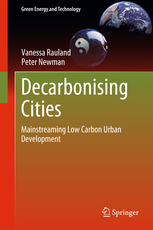Decarbonising Cities: Mainstreaming Low Carbon Urban Development

Decarbonising Cities explores how urban development can be harnessed to minimize natural resource depletion and climate change. Instead of discussing environmental problems at length, it focuses on potential solutions – with cities at the core. For the authors, these solutions depend on accurate measurements of carbon emissions and a push toward low-carbon or carbon-neutral practices. Crucial here is an understanding of the contribution that cities can make to global greening.
Decarbonising Cities first provides some background on measurement of carbon emissions. The literature shows that cities play a role in both producing and limiting these – for instance through density, transport and the concentration of innovation. The authors identify water, waste and energy as among the most important areas where improvements can be achieved, and give examples of how environmental impacts have been reduced in these areas. Several eco-cities and eco-precincts are analysed (mainly in Australia, the regional focus of this book). For instance, the desert city of Masdar in the United Arab Emirates seeks to be a zero-carbon, zero-waste city. It has been working toward this ambitious goal through a raft of measures including waterless urinals, narrow streets that funnel wind, and gasification of waste to produce energy.
For Rauland and Newman, greener cities should meet several criteria. They should be more technologically up to date and open to innovation. They should also embrace decentralization. This would make transport and distribution more efficient, as well as reducing the vulnerability that can blight large-scale, inflexible systems in times of crisis.
The smaller scale championed by the authors goes down to the precinct or neighbourhood level. The reasoning is that this level is where communities, urban developers and local governments work and form relationships. The precinct level also presents numerous opportunities for carbon reduction.
Alongside scale, the other main issue is measurement. Assessment of emissions is plagued by inconsistency in the terminology, reporting and frameworks used. For instance, carbon footprints are calculated in a number of ways. This limits the credibility of claims to be “carbon neutral” or “zero carbon” and underscores the need for certification of carbon neutrality. Applying this measurement issue to cities, it can be challenging to assign emissions to particular urban areas, especially when consumption and production activities can take place very far from each other. And of course it is difficult to understand how to limit carbon emissions if we cannot make comparisons.
Decarbonising Cities outlines several existing tools for counting carbon emissions in cities, including international schemes and those applicable to the precinct level. However, the authors argue that what is missing is a comprehensive framework that bridges global knowledge and local applicability, while taking account of what the literature on climate change and cities has established. This leads to the culmination of the book’s ideas: a global accounting framework for carbon emissions, to be applied at the precinct level. The book provides detailed guidelines for this accounting, incorporating planning, construction, governance and behaviour. It also presents recommendations for incentives to encourage urban developers to reduce carbon emissions. Thus the book ends on a practical note, seeking to encourage change.
Further reading:
Dodman, David (2009), “Blaming cities for climate change? An analysis of urban greenhouse gas emissions inventories”, Environment and Urbanization Vol 21, No 1, pages 185–201, available at http://eau.sagepub.com/content/21/1/185.abstract.
Kenworthy, Jeffrey R (2006), “The eco-city: ten key transport and planning dimensions for sustainable city development”, Environment and Urbanization Vol 18, No 1, pages 67–85, available at http://eau.sagepub.com/content/18/1/67.abstract.
Newman, Peter (2006), “The environmental impact of cities”, Environment and Urbanization Vol 18, No 2, pages 275–295, available at http://eau.sagepub.com/content/18/2/275.abstract.
Book note prepared by Christine Ro
Search the Book notes database
Our Book notes database contains details and summaries of all the publications included in Book notes since 1993 - with details on how to obtain/download.
Use the search form above, or visit the Book notes landing page for more options and latest content.
For a searchable database for papers in Environment and Urbanization, go to http://eau.sagepub.com/

